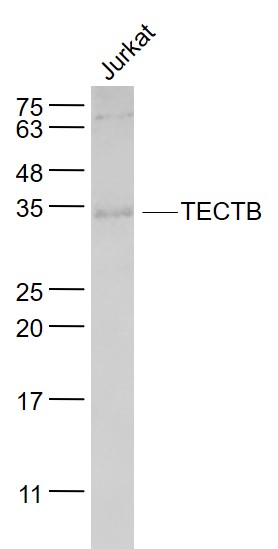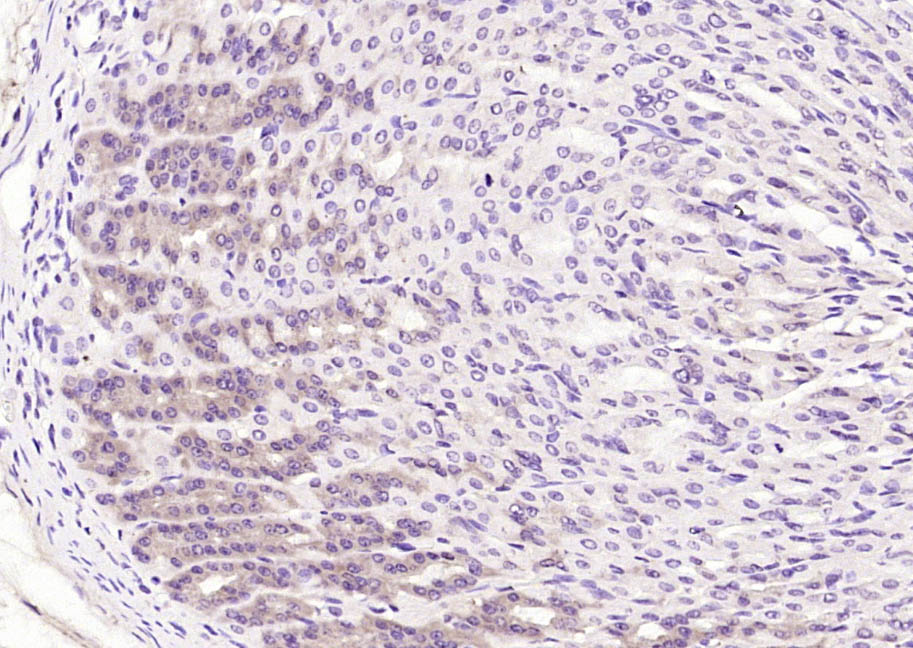
Rabbit Anti-TECTB antibody
Beta-tectorin; Tectb; TECTB_HUMAN; Tectorin beta.
View History [Clear]
Details
Product Name TECTB Chinese Name 遗传性耳聋β-tectorin抗体 Alias Beta-tectorin; Tectb; TECTB_HUMAN; Tectorin beta. Research Area Neurobiology Signal transduction Cell adhesion molecule Cytoskeleton Extracellular matrix Immunogen Species Rabbit Clonality Polyclonal React Species Human, Rat, (predicted: Mouse, Dog, Pig, Cow, Rabbit, Sheep, ) Applications WB=1:500-2000 ELISA=1:5000-10000 IHC-P=1:100-500 IHC-F=1:100-500 ICC=1:100-500 IF=1:100-500 (Paraffin sections need antigen repair)
not yet tested in other applications.
optimal dilutions/concentrations should be determined by the end user.Theoretical molecular weight 32kDa Cellular localization The cell membrane Extracellular matrix Secretory protein Form Liquid Concentration 1mg/ml immunogen KLH conjugated synthetic peptide derived from human TECTB: 101-200/329 Lsotype IgG Purification affinity purified by Protein A Buffer Solution 0.01M TBS(pH7.4) with 1% BSA, 0.03% Proclin300 and 50% Glycerol. Storage Shipped at 4℃. Store at -20 °C for one year. Avoid repeated freeze/thaw cycles. Attention This product as supplied is intended for research use only, not for use in human, therapeutic or diagnostic applications. PubMed PubMed Product Detail Beta-tectorin is a 329 amino acid secreted protein that contains one zona pellucida (ZP) domain. While it may form homomeric filaments after self-association, Beta-tectorin may also form heteromeric filaments when it associates with ?tectorin. The presence of a hydrophobic C-terminus preceded by a potential cleavage site strongly suggests that tectorins are synthesized as glycosylphosphatidylinositol-linked, membrane-bound precursors. Tectorins are targeted to the apical surface of the inner ear epithelia and proteolytically released into the extracellular compartment. Beta-tectorin is one of the major non-collagenous components of the tectorial membrane. The tectorial membrane is an extracellular matrix of the inner ear that covers the neuroepithelium of the cochlea and contacts the stereocilia bundles of specialized sensory hair cells. Sound induces movement of these hair cells relative to the tectorial membrane, deflects the stereocilia and leads to fluctuations in hair-cell membrane potential, transducing sound into electrical signals.
Function:
One of the major non-collagenous components of the tectorial membrane (By similarity). The tectorial membrane is an extracellular matrix of the inner ear that covers the neuroepithelium of the cochlea and contacts the stereocilia bundles of specialized sensory hair cells. Sound induces movement of these hair cells relative to the tectorial membrane, deflects the stereocilia and leads to fluctuations in hair-cell membrane potential, transducing sound into electrical signals.
Subunit:
May form homomeric filament after self-association or heteromeric filament after association with alpha-tectorin.
Subcellular Location:
Cell membrane. Secreted; extracellular space; extracellular matrix. Found in the non-collagenous matrix of the tectorial membrane.
Post-translational modifications:
The presence of a hydrophobic C-terminus preceded by a potential cleavage site strongly suggests that tectorins are synthesized as glycosylphosphatidylinositol-linked, membrane-bound precursors. Tectorins are targeted to the apical surface of the inner ear epithelia by the lipid and proteolytically released into the extracellular compartment.
Similarity:
Contains 1 ZP domain.
SWISS:
Q96PL2
Gene ID:
6975
Database links:Entrez Gene: 6975 Human
Entrez Gene: 21684 Mouse
Omim: 602653 Human
SwissProt: Q96PL2 Human
SwissProt: O08524 Mouse
Unigene: 348615 Human
Product Picture
Jurkat(Human) Cell Lysate at 30 ug
Primary: Anti- TECTB (SL11067R) at 1/1000 dilution
Secondary: IRDye800CW Goat Anti-Rabbit IgG at 1/20000 dilution
Predicted band size: 32 kD
Observed band size: 32 kD
Paraformaldehyde-fixed, paraffin embedded (rat stomach); Antigen retrieval by boiling in sodium citrate buffer (pH6.0) for 15min; Block endogenous peroxidase by 3% hydrogen peroxide for 20 minutes; Blocking buffer (normal goat serum) at 37°C for 30min; Antibody incubation with (TECTB) Polyclonal Antibody, Unconjugated (SL11067R) at 1:200 overnight at 4°C, followed by operating according to SP Kit(Rabbit) (sp-0023) instructionsand DAB staining.
Bought notes(bought amounts latest0)
No one bought this product
User Comment(Total0User Comment Num)
- No comment




 +86 571 56623320
+86 571 56623320
 +86 18668110335
+86 18668110335

